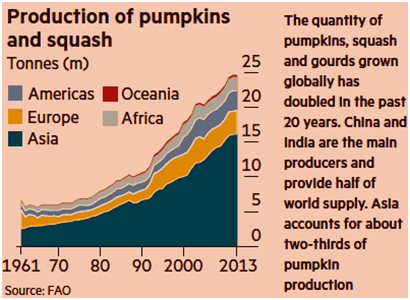Summer is over and the leaves are turning. The US’ Federal Reserve branch in Atlanta continued to lower US growth expectations from +3.5% annualized to only +2.2% annualized. The IMF also chimed in with a lower GDP growth revision though for all of 2016 at +1.6%, down from their July forecast of +2.2%. Economic news continues to be mixed though no obvious systemic risk is out there (we believe that both the election as well as any interest rate hike in December will have only a modest and perhaps offsetting impact on the markets). The Puerto Rico bankruptcy (or equivalent) will also not move forward until December or early 2017 – far off in the future in these markets. The ECB stepped up its corporate bond buying and more concerns were raised over the misalignment between the country breakdown targets of their purchases versus the availability of sovereign bonds to actually buy; at the current rate and targets, the ECB will run out of eligible German and Finnish bonds in February next year. Will they lower their standards or taper their purchases? The answer is obvious. The Italian referendum to restructure their government and the third Spanish election attempt to form a government are upcoming in December. Meanwhile, more concerns over internal Chinese debt were raised as the central government expanded its municipal bond swap program and combined a few money-losing heavy industry government enterprises without culling workers or excess capacity. Extend and pretend. Japan’s central bank changed some of its yield curve targeting but in a confusing way so that even bank analysts failed to have cohesive opinions on what it meant. Not a successful communication policy at least. OPEC at least can communicate that it wants to cut oil production – though no certainty on by whom and how much – that is for November’s meeting. Big producers like Russia, US, China and Mexico are not bound to any cuts so it seems implausible that any agreement will hold together for long. In addition, the timing happens to coincide with seasonal maintenance for many of the OPEC members so they may declare victory with the temporary seasonal cuts and then re-expand citing changing circumstances. Grain harvests are in full swing in the North America with decent progress, though a little behind last year. Softs (coffee, sugar and cocoa) still are dealing with adverse weather reports. US livestock supplies are looking particularly plentiful and a weaker Yuan is holding back export demand. Although much in the markets and news seems more of the same, we expect some of the above events will shake the markets by the end of the year. Until then, safe trading!
Still No Surprises! Janet Yellen and the Federal Reserve may have been officially split about raising rates at the September meeting, but the Federal Reserve will not do anything before the election. Furthermore, the Fed governors’ median interest rate projections for 2017 fell from 1.6% to 1.1% and for 2018 from 2.4% to 1.9% – in other words, “lower for longer.”  The current “dot plot” is to the right, showing that the majority of the members are expecting one more increase in 2016 – and it sure will not occur at the November 1st and 2nd meeting. Look ahead to December 13-14th for that possibility. However, with the Atlanta Federal Reserve’s projection for Q3 GDP revised down continuously during September from +3.5% annualized to only +2.2% annualized, inflation concerns are also correspondingly deflating and with them the likelihood of that final increase. Q2 GDP growth was finalized at +1.4% annualized rate – not great but better than the previous estimate of +1.1%. We shall see how Q3 plays out.
The current “dot plot” is to the right, showing that the majority of the members are expecting one more increase in 2016 – and it sure will not occur at the November 1st and 2nd meeting. Look ahead to December 13-14th for that possibility. However, with the Atlanta Federal Reserve’s projection for Q3 GDP revised down continuously during September from +3.5% annualized to only +2.2% annualized, inflation concerns are also correspondingly deflating and with them the likelihood of that final increase. Q2 GDP growth was finalized at +1.4% annualized rate – not great but better than the previous estimate of +1.1%. We shall see how Q3 plays out.
In more granular US economic news, imports from China dropped -3.5% in July, showing slowing trade despite the upcoming US holiday seasons of Halloween, Thanksgiving and Christmas. Pending US sales of existing homes fell to a seven-month low as high prices discouraged buyers. New home sales (about 10% of the market) beat the survey at 609,000 sold versus 600,000, continuing the uptrend since 2010. Borrowing costs were steady and some wage growth should be supportive but strong price appreciation is a challenge. Retail sales declined more than expected (-0.3% versus -0.1%) as a downtick in automobile purchases met a decline in seven of the twelve categories besides autos. Durable goods orders were little changed in August, though non-military, non-aircraft grew +0.6%, higher than expected. Factory output declined more than forecast in August (-0.4% versus -0.3%) – though oil and gas drilling expanded +3.2%, confirming the increase in rig counts reported separately. Jobless claims stayed low (see graph to the right) 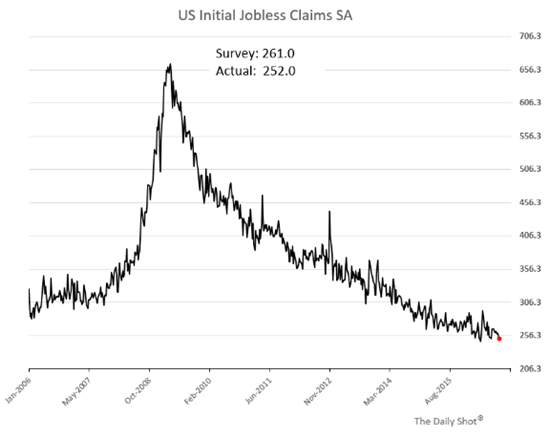 while vehicle sales to consumers stayed flat versus the start of the year. Finally, foreign central banks have cut their purchases of US government bonds, with China and Japan cutting their purchases for the third consecutive quarter and Saudi Arabia reducing their holdings. These top holders of US debt need to fund their deficits and with possible rate hikes, taking some money off the table (perhaps just temporarily) fits their needs. While a non-issue in the immediate future, the US deficits are set to increase in the coming fiscal year and beyond per the Congressional Budget Office. Something to monitor as we finish the year and go into 2017.
while vehicle sales to consumers stayed flat versus the start of the year. Finally, foreign central banks have cut their purchases of US government bonds, with China and Japan cutting their purchases for the third consecutive quarter and Saudi Arabia reducing their holdings. These top holders of US debt need to fund their deficits and with possible rate hikes, taking some money off the table (perhaps just temporarily) fits their needs. While a non-issue in the immediate future, the US deficits are set to increase in the coming fiscal year and beyond per the Congressional Budget Office. Something to monitor as we finish the year and go into 2017.
We all are familiar with the financial woes of Venezuela by now, but even their oil company (PDVSA) may finally succumb to the country’s economic collapse. 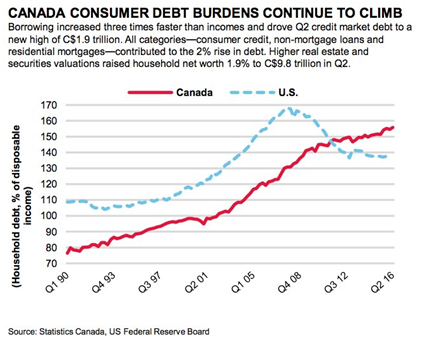 PDVSA is seeking to swap $7 billion of bonds maturing in 2017 for 2020 durations – a small reprieve but they certainly do not have the money now to repay the principal. Can they buy time? With little in assets, PDVSA bonds look like a losing bet. Meanwhile, Canada’s firms and consumers are layering on the debt almost unnoticed – the attached graphs show levels approaching the US highs before the 2008 crash on one measure.
PDVSA is seeking to swap $7 billion of bonds maturing in 2017 for 2020 durations – a small reprieve but they certainly do not have the money now to repay the principal. Can they buy time? With little in assets, PDVSA bonds look like a losing bet. Meanwhile, Canada’s firms and consumers are layering on the debt almost unnoticed – the attached graphs show levels approaching the US highs before the 2008 crash on one measure. 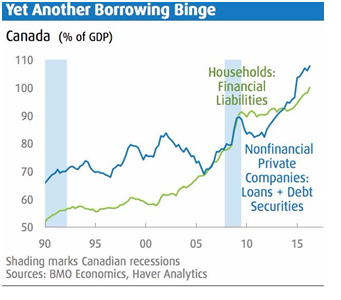 Certainly on a GDP basis the trend is obvious – if not accelerating. With bad oil loans souring bank balance sheets, could the US’ northern neighbor slip on the ice this winter?
Certainly on a GDP basis the trend is obvious – if not accelerating. With bad oil loans souring bank balance sheets, could the US’ northern neighbor slip on the ice this winter?
ECB Pushing on the String: Seven years in, QE in its various forms is not doing anything, apart from the first US program which arguably provided liquidity when the markets needed it (temporarily). The graphs from Citigroup on the right do not include Japan, but given that country’s decline in PMIs and inflation, the result would be in line with the QE2/QE3/ECB experience. 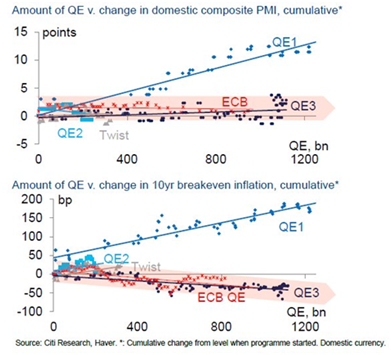 Meanwhile, the ECB’s bond buying program is expected to reach its limits in German and Finnish bonds before the program finishes in March – unless the ECB changes the rules and ditches its country limits (increasing its exposure to more risky countries – such as the PIIGS), its minimum yield limits (allowing it to buy negative-yielding bonds and thus locking in losses) or more corporate bonds (more credit risk and picking corporate favorites – the ultimate too-protected-to-fail since the ECB would bail out any corporates that it would invest in to again avoid losses – per its mandate). All bad choices if one seeks transparency and accountability in markets, but that is not the goal. More market distortion will not solve the ECB’s / EU’s problems, but it does push tough decisions further away (by a few months at least). The UK announced a corporate bond-buying program as well (£10 billion per month for eighteen months). The big banks certainly are still in trouble – Deutsche Bank, Commerzbank, ING, Banco Popular have all announced planned layoffs totaling over 20,000 employees. No one is going bankrupt but no one is recovering either.
Meanwhile, the ECB’s bond buying program is expected to reach its limits in German and Finnish bonds before the program finishes in March – unless the ECB changes the rules and ditches its country limits (increasing its exposure to more risky countries – such as the PIIGS), its minimum yield limits (allowing it to buy negative-yielding bonds and thus locking in losses) or more corporate bonds (more credit risk and picking corporate favorites – the ultimate too-protected-to-fail since the ECB would bail out any corporates that it would invest in to again avoid losses – per its mandate). All bad choices if one seeks transparency and accountability in markets, but that is not the goal. More market distortion will not solve the ECB’s / EU’s problems, but it does push tough decisions further away (by a few months at least). The UK announced a corporate bond-buying program as well (£10 billion per month for eighteen months). The big banks certainly are still in trouble – Deutsche Bank, Commerzbank, ING, Banco Popular have all announced planned layoffs totaling over 20,000 employees. No one is going bankrupt but no one is recovering either.
In economic news, German exports fell surprisingly by -2.6% in July, very different than the +0.2% rise expected. Relatedly, Eurozone industrial production fell -1.1% that month, with the chart to the right indicating that the trend may not be friendly. 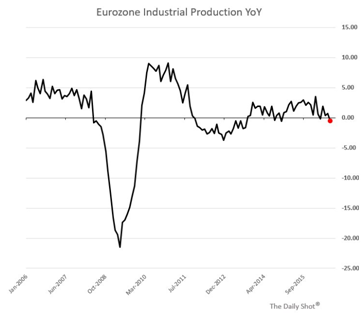 French 2Q GDP was revised down to -0.1% from 0.0%. Construction was more positive than expected (+1.8% versus +0.3% from the month prior). The UK posted some positive economic news with positive manufacturing PMIs. Russia is still struggling with disposable income falling more than expected (-8.3% versus -5.7%, year-on-year) and retail sales continued to stagnate (-5.1% versus -4.9% expected, year-on-year). Turkey’s debt was downgraded to junk levels by Moody’s, which still lags S&P’s rating. Erdogan is making nice with Putin, increasing political risk in the region by an ostensible NATO ally. Finally, Italy will be holding a reforms referendum in December to completely change the structure of their parliament, eliminating one house from all but the most important legislative procedures and shrinking the primary chamber by 2/3s to 100 representatives, speeding up the legislative process overall. PM Renzi has promised to resign if the measure fails – which it could do so easily – and thus potentially send the country into political crisis. December 4th is the date to watch.
French 2Q GDP was revised down to -0.1% from 0.0%. Construction was more positive than expected (+1.8% versus +0.3% from the month prior). The UK posted some positive economic news with positive manufacturing PMIs. Russia is still struggling with disposable income falling more than expected (-8.3% versus -5.7%, year-on-year) and retail sales continued to stagnate (-5.1% versus -4.9% expected, year-on-year). Turkey’s debt was downgraded to junk levels by Moody’s, which still lags S&P’s rating. Erdogan is making nice with Putin, increasing political risk in the region by an ostensible NATO ally. Finally, Italy will be holding a reforms referendum in December to completely change the structure of their parliament, eliminating one house from all but the most important legislative procedures and shrinking the primary chamber by 2/3s to 100 representatives, speeding up the legislative process overall. PM Renzi has promised to resign if the measure fails – which it could do so easily – and thus potentially send the country into political crisis. December 4th is the date to watch.
Is Bigger Better? What is the best way to deal with massive steel companies with bloated capacity? China thinks the answer is to combine them! Baosteel and Wu-Han Iron & Steel Group announced their merger with a third company possible to be added to the mix. 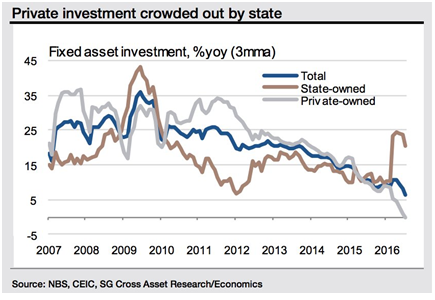 Baosteel alone employs 130,000 workers – about the same as the entire steel industry in the US. With a return of -3.63% on assets, China’s largest mills need to become more efficient, which requires mass layoffs and increased productivity. As 1/3rd of capacity is unused in the oil-processing and steel sectors, there are no easy choices for a Communist government committed ideologically to heavy industry and its related proletariat. Meanwhile the export markets are still under pressure, with container throughput in Hong Kong down 10% year-on-year. Hong Kong retail sales also missed as they declined -10.5% year-on-year versus the -6.9% expected. Chinese excess port capacity is equal to the entire active capacity of Russia, Japan, South Korea and Taiwan combined, per the Financial Times!
Baosteel alone employs 130,000 workers – about the same as the entire steel industry in the US. With a return of -3.63% on assets, China’s largest mills need to become more efficient, which requires mass layoffs and increased productivity. As 1/3rd of capacity is unused in the oil-processing and steel sectors, there are no easy choices for a Communist government committed ideologically to heavy industry and its related proletariat. Meanwhile the export markets are still under pressure, with container throughput in Hong Kong down 10% year-on-year. Hong Kong retail sales also missed as they declined -10.5% year-on-year versus the -6.9% expected. Chinese excess port capacity is equal to the entire active capacity of Russia, Japan, South Korea and Taiwan combined, per the Financial Times! 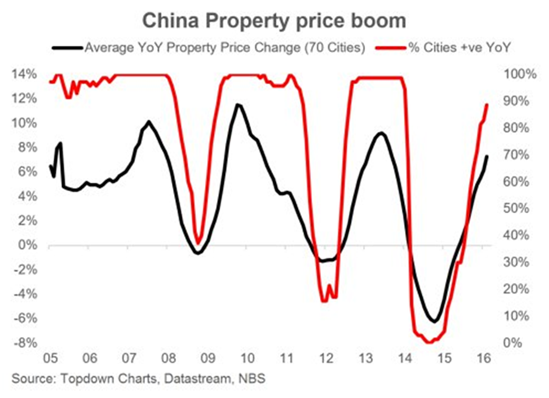 And unused Chinese capacity is expected to double by 2030 as local governments expand ports to compete on larger facilities to attract business and jobs. Sounds like a losing game. On the plus side, the official figures were positive for August as industrial production grew +6.3% (the fasted annualized pace since March), retail sales increased +10.6% annualized (versus +10.2% in July) and the official PMI number hit a ten-month high of 50.4, showing a mild increase. Property prices accelerated their move back up and per the graph on the left, the gains are broad-based (90% of the major cities). There is official reporting that the central government is permitting higher local government spending to maintain the economy – “off-balance sheet” financing has already hit RMB 1.1 trillion ($160 billion) through September versus RMB 0.9 trillion ($150 billion) of “extra” spending for all of 2015. Fiscal stimulus is in full swing, though not much to show for it as state spending is crowding out private spending (see graph to the left). The ascribed opposite view is that the government is simply stepping into the private economy’s weakness. However, when to back off from the torrent of spending is the question.
And unused Chinese capacity is expected to double by 2030 as local governments expand ports to compete on larger facilities to attract business and jobs. Sounds like a losing game. On the plus side, the official figures were positive for August as industrial production grew +6.3% (the fasted annualized pace since March), retail sales increased +10.6% annualized (versus +10.2% in July) and the official PMI number hit a ten-month high of 50.4, showing a mild increase. Property prices accelerated their move back up and per the graph on the left, the gains are broad-based (90% of the major cities). There is official reporting that the central government is permitting higher local government spending to maintain the economy – “off-balance sheet” financing has already hit RMB 1.1 trillion ($160 billion) through September versus RMB 0.9 trillion ($150 billion) of “extra” spending for all of 2015. Fiscal stimulus is in full swing, though not much to show for it as state spending is crowding out private spending (see graph to the left). The ascribed opposite view is that the government is simply stepping into the private economy’s weakness. However, when to back off from the torrent of spending is the question.
The Bank of Japan at its September meeting committed to keeping ten-year bond yields at zero – essentially being ready to buy any amount to keep yields at that level. Reaction was mixed as this approach has only be used once before (in the US after World War II), and it was considered ineffective and abandoned. Of BOJ is still buying equities and changed their purchases to include the TOPIX index and related ETFs (annual amount at ¥5.7 trillion or about $55 billion). A little prop to equity holders. Finally Australia is looking to issue its longest-maturity bond yet – thirty years – to lock in low financing rates for longer. How low will its rates go?
OilPECalypse: OPEC may have sparked the price reaction that they were looking for when Saudi Arabia finally caved and a deal was announced to cut the group’s production. Of course, the amount and by whom was put off until the November 30th meeting and by then production will have declined naturally because of seasonal maintenance. In the meantime, Russian production hit a post-Soviet high to 11.11 million barrels per day (mbpd), the highest for any producer. 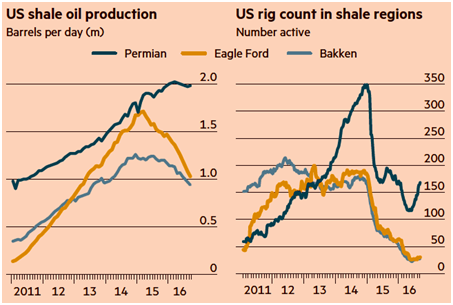 Iran is still looking to expand from recent highs – their oil and condensate exports reached pre-sanction levels of 2.8 mpbd. Iraq’s production is set to increase, Brazilian production is back to its 2015 highs, Libya reopened exports and began shipping, and Nigerian production is expanding and re-exporting. In short, OPEC oil output is set to reach an all-time high in September and perhaps beyond. Ironically, in the beginning of September, both OPEC and the International Energy Agency both predicted that the oil supply glut will continue through 2017. OPEC’s actions may change that trajectory but if the world economy stays sluggish, then prices would likely stay low without more drastic action. US shale oil is already reacting as rig counts continued their increase from 407 on September 2nd to 425 on September 30th. Costs are falling sharply, with an example well on the east side of the Permian Basin in Texas seeing cost per square foot falling by 48% since Q1 2015 while average Permian oil well output has increased 122% since 2012. The FT graphs to the right outline the dramatic geographical impact. Mexico too this month outlined its shale potential as the Eagle Ford Basin extends not only south of the US border but well into the heart of Mexico. China is ending its routine maintenance season and bringing back on line its idled refiners, which may improve oil demand but also gasoline and diesel supply. At some point soon the refining business may have to deal with its own overcapacity. Finally, Argentina and the UK are considering a joint venture to develop oil fields around the Falklands Islands: an ironic turn of events given the war fought over these rocks back in 1982.
Iran is still looking to expand from recent highs – their oil and condensate exports reached pre-sanction levels of 2.8 mpbd. Iraq’s production is set to increase, Brazilian production is back to its 2015 highs, Libya reopened exports and began shipping, and Nigerian production is expanding and re-exporting. In short, OPEC oil output is set to reach an all-time high in September and perhaps beyond. Ironically, in the beginning of September, both OPEC and the International Energy Agency both predicted that the oil supply glut will continue through 2017. OPEC’s actions may change that trajectory but if the world economy stays sluggish, then prices would likely stay low without more drastic action. US shale oil is already reacting as rig counts continued their increase from 407 on September 2nd to 425 on September 30th. Costs are falling sharply, with an example well on the east side of the Permian Basin in Texas seeing cost per square foot falling by 48% since Q1 2015 while average Permian oil well output has increased 122% since 2012. The FT graphs to the right outline the dramatic geographical impact. Mexico too this month outlined its shale potential as the Eagle Ford Basin extends not only south of the US border but well into the heart of Mexico. China is ending its routine maintenance season and bringing back on line its idled refiners, which may improve oil demand but also gasoline and diesel supply. At some point soon the refining business may have to deal with its own overcapacity. Finally, Argentina and the UK are considering a joint venture to develop oil fields around the Falklands Islands: an ironic turn of events given the war fought over these rocks back in 1982.
In grain news, Australia’s wheat crop is to be the largest in five years – a record 28 million tonnes. Egypt, the world’s largest wheat importer at over 12,000 annually (Indonesia is number two at 8,000 as a point of comparison), suspended imports temporarily over flip-flopping on its fungus standards – imposing at first a zero tolerance versus the world standard of 0.05% and then finding that no one could meet that criterion (at least at a price that Egypt could afford). Brazil is producing a bumper crop of coffee at 54.9 million bags and it is of good quality too per reports. Cocoa production is still reeling in Ivory Coast but Ghana (who makes excellent beans) has increased its crop by 11% versus last year (and is expected to increase it again next year the same percentage). Sugar production remains tight as forecasts look worse for next year. In livestock, an abundance of hogs is depressing prices as the number of piglets per litter continued its steady increase back over 10.5 and US inventory reached a record 65 million hogs. Chinese demand growth is also slowing year-on-year on the weaker Yuan and tepid economic activity. However, China is opening its doors to US beef “soon” but at an unknown time. The country has been closed since 2003 over “mad cow” disease concerns but that may be changing. US exports will face tough competition from Brazil and Australia, the incumbents. Brazil also has received permission to expand its exports to the US to include fresh beef, though no plants have yet been approved for import by the USDA.
Finally, in keeping with the season, Halloween enthusiasts need not take fright over the state of this year’s U.S. pumpkin crop. Supplies of the orange-yellow fruit are much more plentiful than last year, easing concerns of a possible shortage for carving jack-o’-lanterns and buying filling for pumpkin pies. U.S. store supplies of canned pumpkin have almost overcome the effects of last year’s shortage, which was caused by damage to crops from heavy rains in parts of the Midwest. Globally pumpkins and squash production continues to expand as seen in the (slightly outdated) chart below:
Best of investing!
David Burkart, CFA
Coloma Capital Futures®, LLC
www.colomacapllc.com
Special contributor to aiSource
October 6, 2016
Additional information sources: BAML, BBC, Bloomberg, Deutsche Bank, Financial Times, The Guardian, JP Morgan, PVM, Reuters, South Bay Research, Wall Street Journal and Zerohedge.

